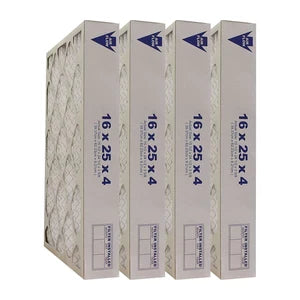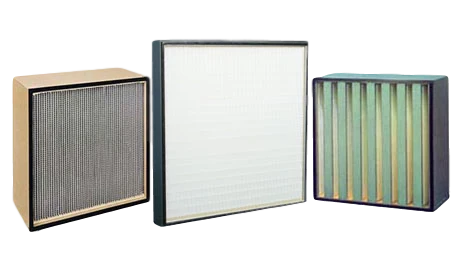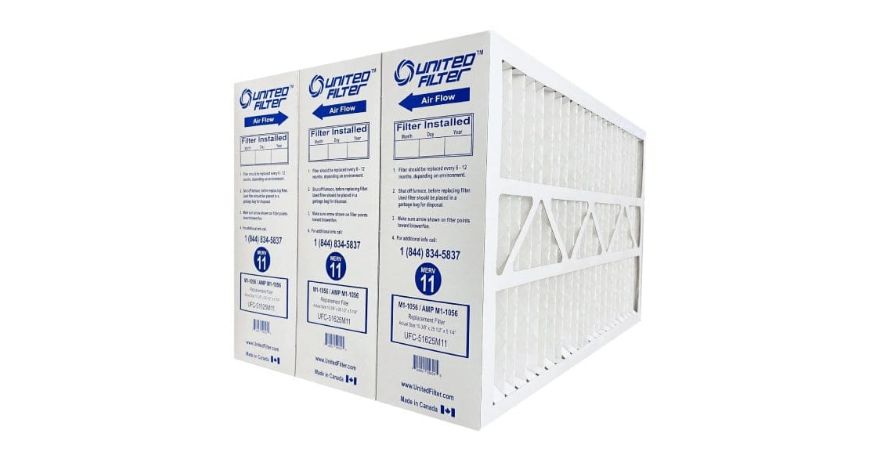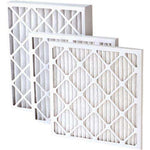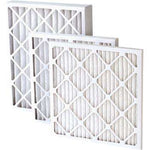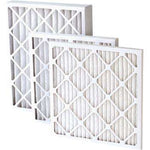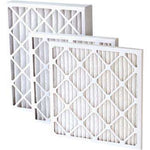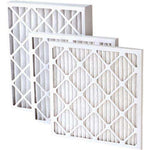You have no items in your shopping cart.
From MERV Ratings to Sizing: 4 Types of Furnace Air Filters You Should Know
Furnace air filters accomplish two significant roles: maintaining your heating and cooling (HVAC) system and preserving the air quality in your home.
Furthermore, furnace filters act as the first line of defence, preventing dust, pollen, and other airborne particles from circulating through your HVAC system.
There’s a wide variety of furnace air filters in the North American market, which can be overwhelming.
Examples of products in the market include Canadian-made aftermarket filters and OEM filters, which have pros and cons.
Owing to their importance and the variety available in the market, you must find the right one to ensure good air quality and preserve your equipment.
This guide will help maneuver the labyrinth of furnace filters, putting you on track to finding the ideal product for your needs.

Understanding Furnace Air Filters: What Type of Filter Is Best for My Furnace?
The purpose of furnace air filters is to trap contaminants as air passes through your heating and cooling system.
Furnace filters come in different sizes that fit into a specific HVAC system, so it is crucial to know and purchase the accurate size.
A filter typically has three main components depending on type and quality:
- Frame:
It supports the filter, ensuring it doesn't fail as air is passed through it for cleaning.
The frame is made of different materials, ranging from cardboard to metal.
- Filter material:
Fiberglass is the most common material used for HVAC filters. It acts as a screen that captures dust and traps small particles.
The filter's efficacy is measured using the MERV rating system (which we will discuss later): the higher the rating, the more effective furnace filters.
- Mesh:
The mesh runs on the surface of the filter, providing extra rigidity.
It may also be made of metal, which in this case also carries an electrostatic charge to trap dust particles for cleaner air.
These components form the foundation for the different furnace filters on sale in North America.
Every filter type serves specific needs; therefore, you need to understand their different functions to determine which is ideal for your home.
How do I know what furnace filter I need?
First, you need to know the filter's purpose and capabilities to improve air quality while protecting your air conditioning system.
You also need to identify the specific size that fits your system and its longevity before replacement, which also impacts the costs.
Let's first look at some varieties available and their functions in improving air quality.

Furnace Filters That Are Right For You
1. Fiberglass Filters:
They are an affordable option that works well for households looking to trap large particles.
However, they may not be effective for smaller particles like pollen, mould spores, or bacteria.
They are often unsuitable for households with allergies or respiratory issues and require frequent replacement.
2. Pleated Filters:
These filters provide more effective filtration with denser material that traps a wide range of contaminants.
Thanks to their pleats, they have a larger surface area that captures more particles, making them durable and efficient.
Pleated house air filters are dense but don't restrict airflow, meaning your machines don't have to work harder.
For the best furnace filters, find options rated MERV 8 to MERV 13.
3. Washable/ Reusable Filters:
They are an eco-friendly and cost-effective option for Canadian homeowners who want to reduce waste.
Reusable filters can be made from polypropylene media, aluminum, or plastic and can be cleaned and reused for several years.
In addition, reusable filters usually have lower MERV ratings.
Leaving them uncleaned for long durations can reduce HVAC filter efficiency.
4. Metal Filters:
These types are primarily for industrial applications, but there are compact varieties for homes.
Metal filters mainly capture larger particles, making them ideal for homes without special filtration needs. They're often found with electronic furnace air cleaners.
Now that we have a good idea of the types of furnace air filters on the market, we need to know how to identify quality furnace filters.

What Makes Quality Furnace Air Filters?
There are a few considerations that help identify the quality of furnace filters.
The checks range from ratings to manufacturing; let us highlight the fundamentals:
1. Canadian-Made Aftermarket vs OEM Filters
Original Equipment Manufacturers (OEMs) are brands that make HVAC equipment and brand-specific replacement filters.
OEM furnace filters are made for your specific HVAC model and fit perfectly, but they may be expensive.
Canadian-made aftermarket HVAC filters are the go-to for Canadian homeowners seeking affordable furnace air filtration without compromising quality.
What are aftermarket furnace filters? They are house air filters made by a company other than the OEM but made to match the working specification of the original.
Aftermarket furnace filters in Canada use materials similar to OEM and meet comparable standards at a lower price.
The only challenge with Aftermarket furnace air filters is getting the right size for your model.
To avoid reshipping costs, you may need to partner with a reliable furnace filter company that verifies you have bought the correct size. Also, check the manufacturer manuals for the specifications.
2. MERV Ratings
Minimum Efficiency Reporting Value (MERV) is a rating that indicates the size of particles the filters capture.
The MERV range is between 1 and 16, with 1 indicating large particles (3-10 microns) and 16 catching the smallest particles (0.3-1 microns). The sweet spot is between 8 and 13 MERV ratings.
MERV 8 can capture lint, household dust, dust mites, pollen, and mould, while MERV 13 adds pet dander, smoke, smog, and bacteria to the former list.
It's important to know that air filters shouldn’t restrict airflow. To put it in perspective, you could use cardboard as a filter; yes, it will keep away particles, but it will restrict airflow.
The goal is to balance airflow and filtration.
Higher MERV ratings mean denser screens, which can restrict airflow if your HVAC filters aren’t built for them. So it's essential to confirm your systems' compatibility.
3. Durability and Longevity
How often should a furnace filter be changed? The number of times you should change your filter depends on its durability and longevity.
Occasionally, you’ll find filters rated MERV 13 and above have up to a one-year life, which means you only need to change them once a year.
When changing furnace filters, following the manufacturer's instructions is vital.
The strain on your HVAC can also indicate a clogged filter that needs changing.
A good practice is to check the furnace air filters every 60 days, especially for lower-tier rated filters.
For extra protection, you can consider carbon filters. Carbon filters are top-tier filters, but they can prove problematic as they may restrict good airflow.
Restricted airflow can cause high static pressure, which can lower the lifespan of HVAC systems.

Choosing the Right Furnace Filters Size
When figuring out the correct filter size, two keywords to look for are nominal size and actual size.
The nominal size is typically displayed on the filter’s packaging (e.g., 16x25x1), while the actual size is the precise measurement of the furnace filter, which may be smaller.
For example, a nominal 16x25x5 furnace filter might have dimensions of 15-7/8 x 24-3/4 x 4-⅜.
OEM manufacturers use these termonologies to compel you only to buy their brand-specific furnace air filters.
However, aftermarket furnace filters come in most sizes; the only point you may need to pay attention to is with 5” filters.
5” filters are in three main varieties (depending on the brand) distinguished by their depth dimensions: 4-⅜ Honeywell, 5-¼ Carrier, and 4-⅞ Air bear.
With 5” furnace filters, we always require our customers to specify that they have purchased the correct size to avoid returns.
Although manufacturers use nominal sizes for simplicity, knowing the actual size helps ensure a proper fit, especially for deeper filters (4” and 5” options).

Tips for choosing the right size
- Measure Carefully:
Use a tape measure to determine the precise dimensions of the filter slot, including its length, width, and depth.
Also, check the labelling on the removed filter for dimension, that is, if it was the right one.
- Check Manufacturer's Recommendations:
Some HVAC systems have the size requirement listed in the manuals.
- Consult with Professionals:
United Filter is a professional manufacturer of furnace air filters. We can help you find the right filter for your system.
- Double-check Before Ordering:
When ordering aftermarket filters, verify the actual size to avoid compatibility issues.
Common home filter sizes include
The different sizes are available in respective MERV ratings. Always check for these two parameters when making a purchase.
After you’ve purchased your ideal furnace air filters, all that remains is the installation.
Filter installation is a pretty straightforward process; maybe we can tackle the primary concern in installation:
What Happens if the Furnace Filter Is Backwards?
The most common problem during installation is installing the furnace air filters backwards.
Installing the furnace filter backwards causes the furnace to blow on the non-porous end of the filter, overworking the blower and consuming more energy.
One trick to overcome the issue is purchasing high-quality filters printed with directional arrows.
The arrow points in the direction air flows, which means that during installation, the arrow should always point toward the furnace.
On the other hand, an HVAC professional should be hired to ensure a good installation.

Buy Quality Aftermarket Furnace Air Filters in Canada
United Filter is a manufacturer and distributor of furnace filter products based in Canada.
We offer the most competitive prices on aftermarket filters, delivering on quality and reliability.
Contact us or visit us at our physical shop at #6 - 2624 Royal Windsor Dr. Mississauga, ON L5J 1K7.
If you are a resident of Ontario or Quebec, take advantage of our free shipping.
From MERV Ratings to Sizing: 4 Types of Furnace Air Filters You Should Know
Furnace air filters accomplish two significant roles: maintaining your heating and cooling (HVAC) system and preserving the air quality in your home.
Furthermore, furnace filters act as the first line of defence, preventing dust, pollen, and other airborne particles from circulating through your HVAC system.
There’s a wide variety of furnace air filters in the North American market, which can be overwhelming.
Examples of products in the market include Canadian-made aftermarket filters and OEM filters, which have pros and cons.
Owing to their importance and the variety available in the market, you must find the right one to ensure good air quality and preserve your equipment.
This guide will help maneuver the labyrinth of furnace filters, putting you on track to finding the ideal product for your needs.

Understanding Furnace Air Filters: What Type of Filter Is Best for My Furnace?
The purpose of furnace air filters is to trap contaminants as air passes through your heating and cooling system.
Furnace filters come in different sizes that fit into a specific HVAC system, so it is crucial to know and purchase the accurate size.
A filter typically has three main components depending on type and quality:
- Frame:
It supports the filter, ensuring it doesn't fail as air is passed through it for cleaning.
The frame is made of different materials, ranging from cardboard to metal.
- Filter material:
Fiberglass is the most common material used for HVAC filters. It acts as a screen that captures dust and traps small particles.
The filter's efficacy is measured using the MERV rating system (which we will discuss later): the higher the rating, the more effective furnace filters.
- Mesh:
The mesh runs on the surface of the filter, providing extra rigidity.
It may also be made of metal, which in this case also carries an electrostatic charge to trap dust particles for cleaner air.
These components form the foundation for the different furnace filters on sale in North America.
Every filter type serves specific needs; therefore, you need to understand their different functions to determine which is ideal for your home.
How do I know what furnace filter I need?
First, you need to know the filter's purpose and capabilities to improve air quality while protecting your air conditioning system.
You also need to identify the specific size that fits your system and its longevity before replacement, which also impacts the costs.
Let's first look at some varieties available and their functions in improving air quality.

Furnace Filters That Are Right For You
1. Fiberglass Filters:
They are an affordable option that works well for households looking to trap large particles.
However, they may not be effective for smaller particles like pollen, mould spores, or bacteria.
They are often unsuitable for households with allergies or respiratory issues and require frequent replacement.
2. Pleated Filters:
These filters provide more effective filtration with denser material that traps a wide range of contaminants.
Thanks to their pleats, they have a larger surface area that captures more particles, making them durable and efficient.
Pleated house air filters are dense but don't restrict airflow, meaning your machines don't have to work harder.
For the best furnace filters, find options rated MERV 8 to MERV 13.
3. Washable/ Reusable Filters:
They are an eco-friendly and cost-effective option for Canadian homeowners who want to reduce waste.
Reusable filters can be made from polypropylene media, aluminum, or plastic and can be cleaned and reused for several years.
In addition, reusable filters usually have lower MERV ratings.
Leaving them uncleaned for long durations can reduce HVAC filter efficiency.
4. Metal Filters:
These types are primarily for industrial applications, but there are compact varieties for homes.
Metal filters mainly capture larger particles, making them ideal for homes without special filtration needs. They're often found with electronic furnace air cleaners.
Now that we have a good idea of the types of furnace air filters on the market, we need to know how to identify quality furnace filters.

What Makes Quality Furnace Air Filters?
There are a few considerations that help identify the quality of furnace filters.
The checks range from ratings to manufacturing; let us highlight the fundamentals:
1. Canadian-Made Aftermarket vs OEM Filters
Original Equipment Manufacturers (OEMs) are brands that make HVAC equipment and brand-specific replacement filters.
OEM furnace filters are made for your specific HVAC model and fit perfectly, but they may be expensive.
Canadian-made aftermarket HVAC filters are the go-to for Canadian homeowners seeking affordable furnace air filtration without compromising quality.
What are aftermarket furnace filters? They are house air filters made by a company other than the OEM but made to match the working specification of the original.
Aftermarket furnace filters in Canada use materials similar to OEM and meet comparable standards at a lower price.
The only challenge with Aftermarket furnace air filters is getting the right size for your model.
To avoid reshipping costs, you may need to partner with a reliable furnace filter company that verifies you have bought the correct size. Also, check the manufacturer manuals for the specifications.
2. MERV Ratings
Minimum Efficiency Reporting Value (MERV) is a rating that indicates the size of particles the filters capture.
The MERV range is between 1 and 16, with 1 indicating large particles (3-10 microns) and 16 catching the smallest particles (0.3-1 microns). The sweet spot is between 8 and 13 MERV ratings.
MERV 8 can capture lint, household dust, dust mites, pollen, and mould, while MERV 13 adds pet dander, smoke, smog, and bacteria to the former list.
It's important to know that air filters shouldn’t restrict airflow. To put it in perspective, you could use cardboard as a filter; yes, it will keep away particles, but it will restrict airflow.
The goal is to balance airflow and filtration.
Higher MERV ratings mean denser screens, which can restrict airflow if your HVAC filters aren’t built for them. So it's essential to confirm your systems' compatibility.
3. Durability and Longevity
How often should a furnace filter be changed? The number of times you should change your filter depends on its durability and longevity.
Occasionally, you’ll find filters rated MERV 13 and above have up to a one-year life, which means you only need to change them once a year.
When changing furnace filters, following the manufacturer's instructions is vital.
The strain on your HVAC can also indicate a clogged filter that needs changing.
A good practice is to check the furnace air filters every 60 days, especially for lower-tier rated filters.
For extra protection, you can consider carbon filters. Carbon filters are top-tier filters, but they can prove problematic as they may restrict good airflow.
Restricted airflow can cause high static pressure, which can lower the lifespan of HVAC systems.

Choosing the Right Furnace Filters Size
When figuring out the correct filter size, two keywords to look for are nominal size and actual size.
The nominal size is typically displayed on the filter’s packaging (e.g., 16x25x1), while the actual size is the precise measurement of the furnace filter, which may be smaller.
For example, a nominal 16x25x5 furnace filter might have dimensions of 15-7/8 x 24-3/4 x 4-⅜.
OEM manufacturers use these termonologies to compel you only to buy their brand-specific furnace air filters.
However, aftermarket furnace filters come in most sizes; the only point you may need to pay attention to is with 5” filters.
5” filters are in three main varieties (depending on the brand) distinguished by their depth dimensions: 4-⅜ Honeywell, 5-¼ Carrier, and 4-⅞ Air bear.
With 5” furnace filters, we always require our customers to specify that they have purchased the correct size to avoid returns.
Although manufacturers use nominal sizes for simplicity, knowing the actual size helps ensure a proper fit, especially for deeper filters (4” and 5” options).

Tips for choosing the right size
- Measure Carefully:
Use a tape measure to determine the precise dimensions of the filter slot, including its length, width, and depth.
Also, check the labelling on the removed filter for dimension, that is, if it was the right one.
- Check Manufacturer's Recommendations:
Some HVAC systems have the size requirement listed in the manuals.
- Consult with Professionals:
United Filter is a professional manufacturer of furnace air filters. We can help you find the right filter for your system.
- Double-check Before Ordering:
When ordering aftermarket filters, verify the actual size to avoid compatibility issues.
Common home filter sizes include
The different sizes are available in respective MERV ratings. Always check for these two parameters when making a purchase.
After you’ve purchased your ideal furnace air filters, all that remains is the installation.
Filter installation is a pretty straightforward process; maybe we can tackle the primary concern in installation:
What Happens if the Furnace Filter Is Backwards?
The most common problem during installation is installing the furnace air filters backwards.
Installing the furnace filter backwards causes the furnace to blow on the non-porous end of the filter, overworking the blower and consuming more energy.
One trick to overcome the issue is purchasing high-quality filters printed with directional arrows.
The arrow points in the direction air flows, which means that during installation, the arrow should always point toward the furnace.
On the other hand, an HVAC professional should be hired to ensure a good installation.

Buy Quality Aftermarket Furnace Air Filters in Canada
United Filter is a manufacturer and distributor of furnace filter products based in Canada.
We offer the most competitive prices on aftermarket filters, delivering on quality and reliability.
Contact us or visit us at our physical shop at #6 - 2624 Royal Windsor Dr. Mississauga, ON L5J 1K7.
If you are a resident of Ontario or Quebec, take advantage of our free shipping.
